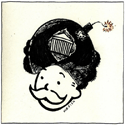|
Bank posted:Looks that way: That's true. If you look at the packaging, they will say that they are not to be sold in CA if they have lead in them.
|
|
|
|

|
| # ? Jun 3, 2024 21:41 |
|
dwoloz posted:What do you guys use as a nail plate/guard for old studs that measure 2" instead of 1.5" I have doubled them up but the pound in ones don't like this to much. Or you can do FHA plates where they screw in and those seem to work much better.
|
|
|
|
I doubled some up, thanks Im surprised there are no off the shelf solutions. Our area is mostly homes built before 1940
|
|
|
|
Question for the Goon Lord Plumbers. The top picture is a top down view of the original cast iron. When I run the washing machine it backs up into the shower and then slowly drains. It's likely just a clog after the 45 deg connection but since I have to take it down to access it anyway I'd like to go ahead and replace the original plumbing. My question is do I have to replace it in the same way it is now or can I use a wye and connect the shower drain further up the washing machine line like in the second drawing?
|
|
|
|
I bought a second hand Kohler cast iron single basin kitchen sink. It has a large chrome reducer ring in the drain opeing that allows a standard size garbage disposer to fit (had a 3 bolt mount installed). I planned to put in a Waste King disposer I bought but bought their "EZ Mount" model instead of the 3 bolt. I can't find any mention online of oversize sink drain openings or the reducer rings. Any idea what this is called? Is it Kohler specific? dwoloz fucked around with this message at 02:24 on Aug 17, 2012 |
|
|
|
TouchyMcFeely posted:Question for the Goon Lord Plumbers. Do it the second way, except your wye is upside down in that picture.
|
|
|
|
jackyl posted:Do it the second way, except your wye is upside down in that picture. It's a horizontal run drawn from the top down perspective. I'm just not sure if you can use a wye unless it's tying into a vertical line.
|
|
|
|
TouchyMcFeely posted:It's a horizontal run drawn from the top down perspective. I'm just not sure if you can use a wye unless it's tying into a vertical line. You can use one as long as the bend isn't too sharp. I think you'd want a long-turn tee-wye (like this: http://www.amazon.com/PVC-DWV-Long-Turn-PVC005011000HA/dp/B000H5RZME), or use a 45° wye connected to another 45° elbow to spread out the bend a bit.
|
|
|
|
Got a picture today 
|
|
|
|
Issues with my kitchen sink. Full pressure with cold water but next to none with the hot water. Rest of the hot water in the house runs normally. Tried turning the valve but it refused to move even with a wrench. Pretty sure that the valve looks like it is corroded with lime/calcium. Any suggestions before I go buy a new valve and replace it and try to clean out the lines? E: this what I am dealing with 
fallin1 fucked around with this message at 00:36 on Aug 20, 2012 |
|
|
|
fallin1 posted:Issues with my kitchen sink. Full pressure with cold water but next to none with the hot water. Rest of the hot water in the house runs normally. Tried turning the valve but it refused to move even with a wrench. Pretty sure that the valve looks like it is corroded with lime/calcium. Any suggestions before I go buy a new valve and replace it and try to clean out the lines? It would be quicker to replace the whole valve. Is that 1/2" galv pipe, with a 3/8" compression fitting on the top? Get a 1/2" FIP inlet, 3/8" comp outlet valve. Use some teflon tape or pipe dope on the lower pipe threads. The faucet supply line won't need any.
|
|
|
|
Ended up having to saw the drat thing off as it wasn't budging with any wrench/combo of wrenches I used. Bought a new 1/2 in pipe and a rubber coupler and just joined them together. Bought a new supply line as well and the hot water is flowing just fine now.
|
|
|
|
A week ago we noticed water coming out of the non-pipe side of my tub. Long story short, the upstairs neighbor's kitchen sink was draining into my bathroom. That's patched up now and we're looking at replacing the old fiberglass shower/tub with a proper tiled shower. Right now I'm shopping for the shower pan. The area currently has a left-hand drain, sticking with that so we don't have to jackhammer any concrete. Beyond that requirement, I'm clueless. Like I can't tell the difference between this and this besides the first one looking like less chance I'll stand in water if it backs up and being $500 more expensive. Is cast iron worth the price? I read some earlier posts in the thread talking about fiberglass shower pans breaking, is that a common thing or would the cheap one be just fine?
|
|
|
|
JawnV6 posted:A week ago we noticed water coming out of the non-pipe side of my tub. Long story short, the upstairs neighbor's kitchen sink was draining into my bathroom. That's patched up now and we're looking at replacing the old fiberglass shower/tub with a proper tiled shower. Cast iron is quieter then fiberglass. If you put mud under a tub or shower its fine. But since I assume you're in a condo, making a tub/shower into a shower reduces the resale value because it doesn't make a full bath. Instead its considered a 3/4 bath. edit: typos Turd Herder fucked around with this message at 06:23 on Aug 21, 2012 |
|
|
|
Rd Rash 1000cc posted:Cast iron is quieter then fiberglass. If you put mud under a tub or shower its fine. But since I assume you're in a condo, making a tub/shower into a shower reduces the resale value because it doesn't make a full bath. Instead its considered a 3/4 bath. Hi there, ~*Significant Other*~ replying. When Jawnv6 said "proper tiled shower," he was referring to tiled walls and not tiled shower floors. I thought that having to do concrete under a shower base was only necessary if you planned on having a tiled shower floor, and was NOT necessary to just pop in a regular shower pan. What do you mean by cast iron being "quieter" than fiberglass? I was all set to order a $222 fiberglass pan because all the better quality material pans are $600+ (and that's a lot of money!), but I don't want to have problems with this a year down the road. Do you think it would honestly be a good investment (and time saver) to go big on this now? Also, how big of a drawback for resale would it be to make the master bathroom into 3/4? We have another full bathroom. (Is there a better thread to ask this question?)
|
|
|
|
Just a word of warning, I originally installed a fiberglass shower pan during my half bath remodel. I followed the instructions when it came to support under the pan to a T. Every time I'd stand on the fiberglass pan it would sag and bend. After about 3 months it cracked and I had to rip it out and throw it away. I ended up replacing it with a Swanstone pan and couldn't be happier. When it comes to bathroom hardware you really don't want to cheap out. The stuff is ridiculously expensive but you're much better off going with a material more substantial than fiberglass. Having to rip out a new bathroom because you tried to save a few bucks sucks rear end.
|
|
|
|
fork bomb posted:Hi there, ~*Significant Other*~ replying. When Jawnv6 said "proper tiled shower," he was referring to tiled walls and not tiled shower floors. I thought that having to do concrete under a shower base was only necessary if you planned on having a tiled shower floor, and was NOT necessary to just pop in a regular shower pan. The cast iron tub doesn't make as much noise when water hits its. Its not a huge deal honestly for the price. And you'd have to move the drain if you want to put in a shower pan since if you have a tub shower right now the drain is to one side. And not in the center.
|
|
|
|
Our 1960 tub has a drip and needs a new drain. The drain I can figure out, the valves I'm not so sure about. Talked to a plumber today who estimated 5 hours to replace the bath and sink (also dripping) valves. I should have asked him but I was still groggy, do the shower valves actually have to be replaced or can they be repaired?
|
|
|
|
Rd Rash 1000cc posted:And you'd have to move the drain if you want to put in a shower pan since if you have a tub shower right now the drain is to one side. And not in the center.  I specifically linked left-hand drain shower pans which match where the drain is currently from the tub. Am I misunderstanding the concept of a left-hand drain? Will we still have to rip up concrete regardless? I specifically linked left-hand drain shower pans which match where the drain is currently from the tub. Am I misunderstanding the concept of a left-hand drain? Will we still have to rip up concrete regardless?
|
|
|
|
JawnV6 posted:
Oh I misunderstood. And never checked the link . You wont have to jack hammer up the concrete. You may have to move the drain slightly depending on if height and center match up. And wormil you can replace the cartridge on the faucet and do the cartridge and seats on the shower valve.
|
|
|
|
Rd Rash 1000cc posted:And wormil you can replace the cartridge on the faucet and do the cartridge and seats on the shower valve. Since we are replacing the hardware I guess I have to replace the valves anyway. I'm just going to let a plumber handle it, the first guy quoted $525 minimum (with an emphasis on "minimum"), the second guy $300 which seems a little more reasonable. The first guy has employees and such to pay for while the second guy is a one man band but both came highly recommended.
|
|
|
|
wormil posted:Since we are replacing the hardware I guess I have to replace the valves anyway. I'm just going to let a plumber handle it, the first guy quoted $525 minimum (with an emphasis on "minimum"), the second guy $300 which seems a little more reasonable. The first guy has employees and such to pay for while the second guy is a one man band but both came highly recommended. How about fixing the valves yourself for under $10? All they need are new washers. You might not see how easy that is because you're looking at your valves the wrong way in your picture... Cartridges come out the front side. Stem washers are for leaks coming out the spout, packing washers are for leaking coming out the handles. I would just replace them both since they're so cheap. Here's some old instructions I wrote: kid sinister posted:I suppose I could give instructions better than in the Fix It Fast thread... Here's the quick version.
|
|
|
|
Well I'm told that if I replace the handles and such that I have to replace the valves. Maybe because its a 50 year old tub?
|
|
|
|
wormil posted:Well I'm told that if I replace the handles and such that I have to replace the valves. Maybe because its a 50 year old tub? A handle is just a part. You can still get replacement handles for 50 year old faucets.
|
|
|
So, I have a problem with my water main. Here's a picture of how it looked before: The main coming in through the wall is a black plastic. It's sort of flexible, but whoever put it in (would have been like ~6 years ago) had it bend down into the main valve. It's kind of a weird connection because the plastic flares out and is compressed into the valve via a nut. The pressure from being bent was completely held by this connection. The original problem was that the valve began to constantly leak, but in the process of me loving around with it the main ripped itself out of the nut. The valve was all hosed up with grit and corrosion in it, so I got a replacement valve of that exact type, but I guess I would need some kind of tool to use on the main to make that flared connection. I was wondering if this would be an OK alternative:  I found an adapter that is barbed on one side and threaded on the other. I guess I could use like a rubber mallet to mate it to the main, but somehow I suspect that's not really the correct procedure. Right now I have an open-rear end water main that's dripping into a jug (service is turned off at the street, but some water is continually dripping out). Any advice?
|
|
|
|
|
SniperWoreConverse posted:So, I have a problem with my water main. Here's a picture of how it looked before: I dont know if barb fittings are allowed by code in your area. I prefer forge fittings for poly pipe. Since they are a long stronger. If you dont get the right sized barbed fitting and its to large. You can expand the poly piping causing it to rip eventually.
|
|
|
|
I don't really know what you mean by forge fitting. I kind of don't know what I'm doing at all.
|
|
|
|
|
SniperWoreConverse posted:I don't really know what you mean by forge fitting. I kind of don't know what I'm doing at all. OK, let's start with the basics. Go take some good pictures of the parts in question and post them here.
|
|
|
|
I'm replacing the faucet in my laundry room sink. In the first picture (the faucet is hanging upside-down with the wall side facing the camera), how many wraps of teflon tape should I use on the threads with the green arrows? What is the purpose of that drain valve looking thing indicated by the red arrow? It will be flush against the wall when installed, so I can't imagine it is an input valve for something like a soap dispenser. It also appears to be after the valves and at the same pressure as the faucet, so I don't think it would be for a spray nozzle - plus there's the whole flush against the wall thing. I just can't figure out what purpose that serves. In the second picture, is that pipe clean enough to solder, or do I need to polish it to a reflective mirror shine?  
|
|
|
kid sinister posted:OK, let's start with the basics. Go take some good pictures of the parts in question and post them here. Good idea, I'll post later on.
|
|
|
|
|
SkunkDuster posted:I'm replacing the faucet in my laundry room sink. In the first picture (the faucet is hanging upside-down with the wall side facing the camera), how many wraps of teflon tape should I use on the threads with the green arrows? I suspect your red arrow points to a 1/4 male that would be used with a compression nut to install a fridge's water line, especially since it seems to be on the cold side.
|
|
|
|
If it has rubber gaskests you don't need any teflon tape. And I can't find a picture of a forge fitting for poly pipe. They may have enough name but worst case you can run the poly pipe and have a plumber hook it up so hes liable.
|
|
|
|
SkunkDuster posted:In the second picture, is that pipe clean enough to solder, or do I need to polish it to a reflective mirror shine? Well yeah, that's clean, but what about the side up against the wall? Also, you're going to have a hell of a time getting a pipecutter on that pipe with it flush to the wall. You could try a hacksaw if you can cut straight across, then use a utility knife to cut off any burrs. If it's still too flush to wall once cut, you'll have a hard time pushing the new fitting on. Also, those cinder blocks can take a blowtorch just fine... but the paint on them can't. Get ready for some scorch marks and awful smells.
|
|
|
|
kid sinister posted:Well yeah, that's clean, but what about the side up against the wall? Also, you're going to have a hell of a time getting a pipecutter on that pipe with it flush to the wall. You could try a hacksaw if you can cut straight across, then use a utility knife to cut off any burrs. If it's still too flush to wall once cut, you'll have a hard time pushing the new fitting on. Whoa there is no reason to burn a surface when soldering close to it. Watch how you angle the torch. I assume that's 1/2 copper. Apply heat on the bottom and the top kind of angled outward. The flame will wrap around the pipe and heat it evenly. Remember to heat the pipe and fitting. Not the entire pipe but drag the flame past where the fitting is like an inch or so just so the cold pipe doesnt make you over heat the fitting and burn it. (burning doesnt hurt the join persay that I know of. But it looks horrible. If you are worried about soldering, to much OP just solder a pex adapter and fit it in pex. Or if you must use a shark bite.
|
|
|
|
That pipe is about 4' long and there is plenty of flex to pull it 6" or so away from the wall when it is time to do the cutting and soldering. It is clean all the way around and burning the wall isn't a concern. I was just wondering if the copper just needed to be clean (as in the picture) or if it needed to be polished to a mirror shine. On the teflon tape question, that joint with the green arrows is one of many. I'm going to install valves (with threaded fittings) upstream from the faucet and those do not have rubber gaskets. Just metal on metal. I should clarify my question and say, "on a threaded joint similar to those indicated by the green arrow, how many wraps of teflon tape should I put on?" Rd Rash 1000cc posted:If you are worried about soldering, to much OP just solder a pex adapter and fit it in pex. Or if you must use a shark bite. I'm not worried about my ability to solder. I have a lot of experience soldering electronic components, so I know enough to use flux and evenly heat the joint - not the solder. However, an electrical connection is different than a plumbing connection, so I was wondering if the joint would adhere better (or worse) with a mirror shine as opposed to a 600 grit shine. Is it better to have a rough surface to give the solder a mechanical bond (like primer), or would it be better to polish it to a mirror finish to maybe give it a better molecular bond? edit: I know I am overthinking this and either way will be just fine and the joint will outlive me. I'm not doing 1000 joints on a timeline - just one lovely basement sink, and I have all the time in the world, so I figure if I'm going to do it, I'll do it the best way I can and maybe learn a thing or two by asking here. Skunkduster fucked around with this message at 19:46 on Aug 29, 2012 |
|
|
|
SkunkDuster posted:That pipe is about 4' long and there is plenty of flex to pull it 6" or so away from the wall when it is time to do the cutting and soldering. It is clean all the way around and burning the wall isn't a concern. I was just wondering if the copper just needed to be clean (as in the picture) or if it needed to be polished to a mirror shine. You should learn the difference between the types of threads first. Compression threads don't need any teflon tape or pipe dope (the putty-like alternative to tape) since they use ferrules or rubber washers instead. Iron pipe threads are the other most common type. Use tape or dope for those any time that they don't have a rubber washer at that joint. Here's a quick example. A garden hose hookup is actually a 3/4" Male Iron Pipe (MIP) connection. Since the hose attachment has a rubber washer inside it, no other sealants are necessary. Don't worry, I started out soldering electronics too. They're almost identical, except plumbing is a little more dangerous with the open flame. You don't need a mirror finish to apply solder to the copper. That's what the flux is for. Just make sure both ends of the joint are shiny and clean, including the female side of the fitting you're putting on the pipe. The male wire brushes you buy at plumbing stores help tremendously for this. I would compare soldering pipe to trying to solder splice together 2 old, corroded wires. If you just strip off the insulation and twist the wires together, when you apply your iron and solder, sure the solder might melt, but it will just ball up on the surface or drip to the floor. It won't get drawn into the wire braids and hold the 2 wires together until you clean both wires first. That "drawing in" is exactly the same thing that you want to see with soldering fittings onto copper pipe. Watch it get drawn in and make sure you have a good bead around the whole perimeter of that fitting. edit: as for your "rough vs. smooth" wondering, the point is moot, actually. Sure, solder is weaker than copper pipe. That's why the joints for solder fittings are as long as they are, to make up for this weakness. They make up for it so much that regarding mechanical strength, the pipe will fail before the joints pull apart, assuming that they were soldered correctly. The only time solder would fail before the pipes and fittings is if that joint was heated above the solder's melting point. kid sinister fucked around with this message at 00:14 on Aug 30, 2012 |
|
|
|
To add to kid sins post. If you are looking at the threads of a pipe with them pointing towards you. Wrap 3-5 wraps of teflon tape clock wise.(start from the furthest away threads wrapping towards the end and ending towards the start of the threads. If you apply it counter clockwise you have an issue of the tape unraveling as you tighten the join. Apply a coat of pipe dope on the tape. You don't have to apply it like its butter on bread. But a thin coat will suffice. (side note the threaded fittings you are using. Make sure they are brass and not Galvanized if you screw them into copper. To prevent electrolysis) On the copper cleaning issues. Use an abrasive pad or sand cloth to clean it. It shouldnt look like standard pipe but be pretty clean with out any dirt on it. Once you clean it don't touch it with your fingers. Since the oil of your fingers will mess up the soldered joint itself. When applying flux, more isn't better. Either use a clean brush or wipe the brush off that you use to apply it. A thin coat t over the pipe will suffice. If you have globs it is to much. The problem with over fluxing the joint is when you heat it you can cause flux pockets that the solder wont adhear too. You basically get bubbles of solder in the join and when you cut the joint open you can see them. Keep your flame moving don't burn the fitting, or burn the flux out of there. If you have some water in the pipe, before cleaning the pipe. Use a torch and boil it out. once it looks dry on the inside let it cool and clean the pipe, flux the joint and pipe and put together. You only need to clean at most a 1/4 inch more pipe then the fitting will cover. Make sure your fitting doesn't move when soldering it. If you have a vertical joint that you have the chance of it slipping out or moving when you heat it. Use channel locks, and pinch the fitting then spin the pipe to lock it in place. Edit: And solder is weaker then copper, you are just using it to fill the joint to keep them together. On a side note Kid sin, ever use a t5 tip on a torch with map gas. The tip of the torch is larger than my thumb It's almost the size of 1" pipe, and its loving amazing. I sweat a 1-1/2 copper like it was 3/4. It was amazing to say the least. Turd Herder fucked around with this message at 06:24 on Aug 30, 2012 |
|
|
|
Rd Rash 1000cc posted:On a side note Kid sin, ever use a t5 tip on a torch with map gas. The tip of the torch is larger than my thumb It's almost the size of 1" pipe, and its loving amazing. I sweat a 1-1/2 copper like it was 3/4. It was amazing to say the least. I haven't had the pleasure yet. I doubt I will too, I'm just a handyman, not a pro. Usually I only fix 1 or 2 joints at a time. The most I've ever... plumbed at once was building that steam sterilizer on the last page. I haven't touched any copper pipe over 3/4". My next job is fixing the job my bro-in-law did for a water heater swap out. Hot and cold are switched, with 2 trickle leaks, one of which is right over the electrical supply. Oh, and he used galvanized nipples too. Oh hey, I have a #7 for that "General plumbing rules" list in the OP. I read your pliers idea and had a bad memory from my past jobs: 7. If you're using a torch to pull apart a joint or to hold a fitting that just won't stay put, use pliers to hold it and not your fingers. You will burn the poo poo out of them otherwise. kid sinister fucked around with this message at 01:50 on Sep 1, 2012 |
|
|
|
kid sinister posted:I haven't had the pleasure yet. I doubt I will too, I'm just a handyman, not a pro. Usually I only fix 1 or 2 joints at a time. The most I've ever... plumbed at once was building that steam sterilizer on the last page. I haven't touched any copper pipe over 3/4". My next job is fixing the job my bro-in-law did for a water heater swap out. Hot and cold are switched, with 2 trickle leaks, one of which is right over the electrical supply. Oh, and he used galvanized nipples too. Wow that would hurt. I like to use channel locks instead of pliars (pumps as seem to also be called)
|
|
|
|

|
| # ? Jun 3, 2024 21:41 |
|
As I'm waiting for the bank to approve a short sale for my first house, my mind has been wandering into home improvement land. After seeing how cheap some shower panels were, it seems like a really nice idea but I haven't any plumbing work. FWIW:  I imagine it's taking apart the current fixtures, refitting the hot and cold water to the panel and them mounting it? I have some old DIY experience, but mainly carpentry. Has anyone done this? I've looked up some resources, but they're for installing it without any existing hardware. It does seem Not Good that the vinyl panel doesn't cover where the showerhead comes out of? Would this need to be cut in to or would space at the top be ok? I don't know how badly leaks may affect the drywall.
|
|
|
























